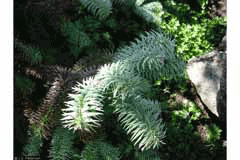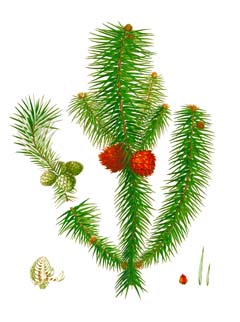 |
|
https://edibleplants.org/ |
 |
| https://edibleplants.org/ |
Translate this page:
Summary
Cunninghamia lanceolata or Chinese Fir is an evergreen tree distinguished by its cone-shaped crown. It usually grows about 50 m in height with a bole diameter of up to 3 m. It is fast growing and highly resistant to pests and diseases. It is widely used for landscaping and has medicinal uses. Its leaves are needle-like, leathery, softly spined, stiff, and green to blue-green in color. Wood decoction is used to treat varnish poisoning, chronic ulcers, hernia, etc. Essential oil from the plant is used to treat pain, bruises, and rheumatism. Bark ash is used for burns, scalds, and wounds. Lastly, cone decoction is used against coughs. The bark is a source of tannins. The essential oil from the branches is used in perfumery. The wood is used in construction, shipbuilding, turnery, fuel, charcoal, etc.
Form: Pyramidal.
Physical Characteristics

 Cunninghamia lanceolata is an evergreen Tree growing to 15 m (49ft) by 6 m (19ft) at a medium rate.
Cunninghamia lanceolata is an evergreen Tree growing to 15 m (49ft) by 6 m (19ft) at a medium rate.
See above for USDA hardiness. It is hardy to UK zone 7. It is in leaf all year, in flower from January to May, and the seeds ripen from August to September. The species is monoecious (individual flowers are either male or female, but both sexes can be found on the same plant) and is pollinated by Wind.
Suitable for: light (sandy), medium (loamy) and heavy (clay) soils. Suitable pH: mildly acid, neutral and basic (mildly alkaline) soils and can grow in very acid soils.
It cannot grow in the shade. It prefers moist soil.
UK Hardiness Map
US Hardiness Map
Synonyms
C. sinensis. Pinus lanceolata.
Plant Habitats
Woodland Garden Canopy; Secondary;
Edible Uses
References More on Edible Uses
Medicinal Uses
Plants For A Future can not take any responsibility for any adverse effects from the use of plants. Always seek advice from a professional before using a plant medicinally.
Antidote Carminative Miscellany Skin
Carminative. A decoction of the wood is used internally in the treatment of varnish poisoning (from species of Rhus), chronic ulcers, hernia etc[ 178 , 218 , 303 ]. The decoction of the wood is used as a bath for smelly feet[ 303 ]. An essential oil from the plant is used to treat bruises, pain, rheumatism and wounds[ 218 , 303 ]. The ash of the bark is used to treat burns, scalds and wounds[ 218 , 303 ]. A decoction of the cone is used in the treatment of coughs[ 218 , 303 ].
References More on Medicinal Uses
The Bookshop: Edible Plant Books
Our Latest books on Perennial Plants For Food Forests and Permaculture Gardens in paperback or digital formats.

Edible Tropical Plants
Food Forest Plants for Hotter Conditions: 250+ Plants For Tropical Food Forests & Permaculture Gardens.
More

Edible Temperate Plants
Plants for Your Food Forest: 500 Plants for Temperate Food Forests & Permaculture Gardens.
More

More Books
PFAF have eight books available in paperback and digital formats. Browse the shop for more information.
Shop Now
Other Uses
Charcoal Miscellany Wood
Agroforestry Uses: The tree is suitable for reforestation schemes in subtropical evergreen, coniferous and mixed broad-leaved forests[ 303 , 329 ]. It is a suitable species for agroforestry systems in China as it is usually intercropped with a number of crops such as maize, beans, wheat, Chinese sorghum, buckwheat, potato, 'ground chestnut' (Arachis hypogaea), tobacco and upland rice; or with other tree species such as the tung oil tree (Aleurites fordii), tea and Litsea cubeba. The interplanting is important not only to increase the income of farmers during early stages of plantations but also to avoid the land degradation that results from continuous cropping of this tree[ 303 ]. Other Uses The bark is a source of tannins[ 303 ]. The branches produce an essential oil that is used in the perfume industry. Cedrol, pinene, phellandrene, citrene, terpinol, thujenol, cadinol and borneol are the main constituents of the oil[ 303 ]. The pale yellow to white, fragrant wood is uniform-textured; straight-grained; light in weight; and durable, though it rots easily if it is continually wet. It is easily worked and resists insect and termite damage. It is used in construction, ship building etc wherever great strength is required. Older and larger branches are used in turnery[ 1 , 46 , 61 , 178 , 303 ]. A good quality fuel and a charcoal can be made from the wood[ 178 , 303 ].
Special Uses
Scented Plants
References More on Other Uses
Cultivation details
Landscape Uses:Pest tolerant, Specimen. A plant mainly of the warm temperate to subtropical zones, just entering into the tropics. It is found at elevations from near sea level to 2,600 metres[ 325 ]. It grows best in areas where the mean annual temperature is in the range 16 - 19°c and is fairly frost resistant - mature plants can tolerate temperatures down to about -15°c[ 418 ]. It prefers a mean annual rainfall in the range 900 - 2,350mm[ 325 ]. Requires a rich warm soil and a sheltered sunny position[ 1 , 164 ]. Best growth is obtained on well-drained loamy soils[ 325 ]. Prefers a pH in the range 5.5 - 6.5, tolerating 5 - 7.5[ 325 ]. Dislikes soil with free lime otherwise the pH is unimportant[ 200 ]. Young trees can make quite rapid growth in height, up to 60cm a year once they have attained more than 1 metre in height[ 185 ]. Before reaching the height of 1 metre, however, they are liable to be killed by frost[ 185 ]. Trees commence coning and producing viable seeds when they are around 6 - 8 years old[ 303 , 325 ]. This is the main re-forestation tree in China[ 46 , 61 ]. The most important fast-growing timber tree of the warm regions south of the Chang Jiang valley of China[ 266 ]. Unlike most conifers, this species can be coppiced, and it also resprouts from the roots if cut down[ 1 , 303 ]. The bruised foliage emits a delicious resinous aroma[ 245 ]. This species is notably resistant to honey fungus[ 200 ]. Special Features:Attractive foliage, Not North American native, Inconspicuous flowers or blooms.
References Carbon Farming Information and Carbon Sequestration Information
Temperature Converter
Type a value in the Celsius field to convert the value to Fahrenheit:
Fahrenheit:
The PFAF Bookshop
Plants For A Future have a number of books available in paperback and digital form. Book titles include Edible Plants, Edible Perennials, Edible Trees,Edible Shrubs, Woodland Gardening, and Temperate Food Forest Plants. Our new book is Food Forest Plants For Hotter Conditions (Tropical and Sub-Tropical).
Shop Now
Plant Propagation
Seed - they have no dormancy and pre-treatment is not necessary. Germination can be improved by soaking the seeds in warm water for a few hours prior to sowing[ 325 ]. Seeds are sown in seed beds, germination begins after 7 days and is terminated after 20 days[ 325 ]. As soon as they are large enough to handle, the seedlings are pricked out into polytubes. Seedlings are normally ready for transplanting into the field in 4 - 5 months later, when they are 35 - 40cm tall[ 325 ]. Vegetative propagation of this species is relatively easy, and at one time most planting stock was produced from coppices from basal stumps after felling[ 325 ]. Nursery seedlings, however, have faster early growth and better survival than coppice sprouts. Since the 1980s, techniques have been developed to produce planting stock from root cuttings[ 325 ]. The cuttings are collected from the root collar when they reach a height of about 10 cm and placed in rooting beds. These cuttings have a survival rate of 90 - 95% and the quality is similar to that of seedling stocks[ 325 ]. Cuttings from lateral shoots are not suitable[ 325 ].
Other Names
If available other names are mentioned here
Native Range
TEMPERATE ASIA: China (Anhui Sheng, Fujian Sheng, Gansu Sheng, Guangdong Sheng, Guangxi Zhuangzu Zizhiqu, Guizhou Sheng, Henan Sheng, Hubei Sheng, Hunan Sheng, Jiangsu Sheng, Jiangxi Sheng, Shaanxi Sheng, Sichuan Sheng, Yunnan Sheng, Zhejiang Sheng), Taiwan TROPICAL ASIA: Cambodia (possibly), Laos, Vietnam (north)
Weed Potential
Right plant wrong place. We are currently updating this section.
Please note that a plant may be invasive in one area but may not in your area so it's worth checking.
None Known
Conservation Status
IUCN Red List of Threatened Plants Status : Cunninghamia lanceolata (Chinese Fir)- Status: Least Concern. No specific threats have been identified for this species. The capacity to coppice and relative intolerance to shade will ensure its survival in cutover forest areas. It is also widely planted

Growth: S = slow M = medium F = fast. Soil: L = light (sandy) M = medium H = heavy (clay). pH: A = acid N = neutral B = basic (alkaline). Shade: F = full shade S = semi-shade N = no shade. Moisture: D = dry M = Moist We = wet Wa = water.
Now available:
Food Forest Plants for Mediterranean Conditions
350+ Perennial Plants For Mediterranean and Drier Food Forests and Permaculture Gardens.
[Paperback and eBook]
This is the third in Plants For A Future's series of plant guides for food forests tailored to
specific climate zones. Following volumes on temperate and tropical ecosystems, this book focuses
on species suited to Mediterranean conditions—regions with hot, dry summers and cool, wet winters,
often facing the added challenge of climate change.
Read More
Expert comment
Author
(Lamb.)Hook.
Botanical References
11200266
Links / References
For a list of references used on this page please go here
Readers comment